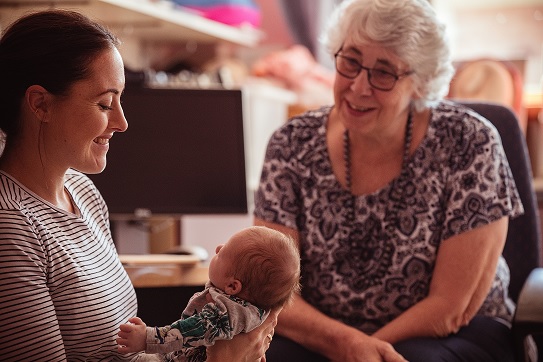In a move deemed “desperately needed” by consumers, Queensland clinicians now have evidence-based guidance on supporting parents with infant sleep.
After multiple rounds of consultation with more than 100 clinicians and consumers, the endorsed Queensland Clinical Guideline ‘Safer Infant Sleep’ is now available. Earlier this month we joined the education session for healthcare workers about the guideline, presented by the QCG team, the University of the Sunshine Coast (UniSC), and the Queensland Paediatric Quality Council (QPQC). Here’s what we learnt.
Sudden Unexpected Death in Infancy (SUDI) is a classification used to describe the sudden death of an infant, usually during sleep, with no immediately obvious cause at the time of death. It includes, but is not limited to, SIDS and fatal sleep accidents.
SUDI is the leading cause of post-neonatal mortality in Australia. While cases of SUDI plummeted throughout the 1990s following public awareness campaigns, rates have since plateaued with little change in incidence since around 2004. Queensland SUDI deaths exceed the national average with First Nations infants over-represented.
The risk of SUDI increases when:
- the infant is exposed to tobacco smoke
- the infant sleeps prone (on their stomach)
- entrapment hazards are present (e.g., sleep on sofa, couches, armchairs)
- infant movement is restricted (e.g., positioning devices, wrapped/swaddled after the infant starts rolling)
- multiple bed sharers (e.g., siblings, pets)
- caregiver excessively tired or sedated by alcohol or drugs.
The QPQC’s Infant Mortality Sub-Committee has reviewed more than 300 deaths and found the risk of infant death is further increased:
- in complex family environments
- in environments with two or more risk factors (listed above) in the sleep setting
- in unsafe shared sleep settings particularly with a vulnerable infant (e.g. antenatal smoke exposure, premature birth)
- when the infant had been placed in an inclined position for sleep.
The findings, in addition to UniSC’s Queensland Infant Care Practices study (I-CARE Study) and the Queensland SUDI study, and consumer feedback, were integral in developing the new Safer Infant Sleep guideline which presents a real opportunity to further reduce rates of SUDI.
And the solution is rooted in risk minimisation, rather than elimination, which many parents have found impractical when caring for their babies at night. “Only 13 per cent of families practice all six of the Safe Sleeping Program messages and only one in four knew all six recommendations,” Professor Jeanine Young AM from UniSC said.
She said 31 per cent of caregivers reported difficulty with implementing Safe Sleep recommendations, with infant sleep position and avoiding bedsharing the most common recommendations which created difficulty for caregivers. “Sometimes parents tried to use substitute sleeping methods that they thought were safe, if they could not follow a recommendation, but sometimes these alternatives actually increased the risk of SUDI.”
One of the key changes in the revised Safer Infant Sleep guideline was a transparent risk minimisation approach relating to shared sleeping, to acknowledge that many parents will bring babies into a shared sleep environment whether they planned to bed-share or not. “A risk minimisation approach supports conversations with caregivers that includes benefits, risks and strategies to create safer sleep environments in order to support informed decision making by caregivers that meets the needs of their family circumstances,” Prof Young said.
“In the I-CARE study, 76 per cent of parents reported that they had shared sleep at some point in the first three months of their baby’s life, and 57 per cent had unintentionally fallen asleep, particularly when breastfeeding or settling their baby. Parents want information on how to share sleep safely so they can create safer shared environments for times they plan to share sleep or may accidently fall asleep with their baby.”
“As health professionals we are in an ideal position to share information and have conversations with caregivers about how to create safer infant sleep environments in a variety of circumstances and settings. The principles of safer infant sleep provided in the Safer Infant Sleep Guideline are intended to support clinicians to have these important conversations,” said Associate Professor Julie McEniery from the QPQC.
Prof Young said maternity care providers needed to regularly discuss infant sleeping with caregivers, including:
- plans for infant sleep
- knowledge of, and experiences with, infant sleep
- risks and benefits of different environments
- strategies for creating safer infant sleep spaces
- shared sleeping (intentional and unintentional situations)
- strategies for when tired or unwell, or away from usual routines or environments.
“The QCG Safer Infant Sleep Guideline provides opportunities for clinicians and the families they serve to have safe, honest and practical conversations about ways to create safer sleep environments that are in line with the social, cultural and practical circumstances families are facing,” Carly Grubb, who provided feedback during guideline development on behalf of Little Sparklers, a parent consumer organisation, said.
“The simplest way to explain safe infant sleep is when it’s easy for baby to breathe, it’s safe for them to sleep,” Prof Young added.
The advice is also pertinent for grandparents and other people who will be involved in caring for the child and isn’t limited to first-time parents. “Consumers watch what we do as clinicians. So, it’s a great opportunity to be a role model and talk through what you’re doing.”
The revised Safer Infant Sleep Guideline and a copy of the education session is available online.
